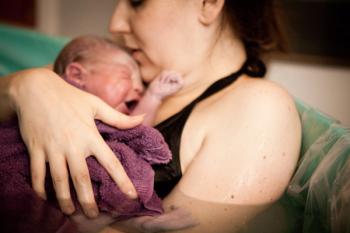
VBAC: Obstetrical Murphy's Law
I would like to share with you my most recent experience with a VBAC case and give some of my own reactions and comments. A 26 y/ G3P2 is admitted at term in dyskinetic labor to the hospital with ruptured membranes.
I would like to share with you my most recent experience with a VBAC case and give some of my own reactions and comments. A 26 y/ G3P2 is admitted at term in dyskinetic labor to the hospital with ruptured membranes. First baby was born by C/Section. Second baby was successful VBAC that weighed 9#6oz, No sweat. Expectant management for first 4-6 hours, minimal cervical progress. Judicious pitocin stimulation done. Good progress, but when baby vertex visible at entroitus, pt could not "push" baby out. She had been given an epidural anesthetic for labor and delivery and also in anticipation of a post-partal tubal ligation shortly after delivery.
Delivery was by low forceps with midline episiotomy. The baby weighed 8#12oz. There was an extension of the episiotomy into the rectal sphincter that required repair. In anticipation of possible shoulder dystocia I had the delivery room nurse put pressure on the suprapubic area of the mother at the time of delivery. Minimal visible lochia at the time of repair. No maternal complaints, vitals all stabel, everyone happy.
Episiotomy repaired, baby off to the nursery. Patient repositioned for tubal ligation. Upon opening the abdomen.....bright red blood. Approx 300 plus cc's. Enlarged the incision to find rupture of the uterus along the right side extending down toward the middle, elevating and bleeding under the bladder flap. Hockey stick shaped. Repair was done like the closure of a previous C/Section incision.
Tubes tied? You bet. Tied. Cut. Thrown down on the floor and stomped on!!! Patient's post op course uneventful. Hemoglobin drop was as expected, but not transfused. Patient dismissed from the hospital on PO #2.
I recount the incidents in this case while it is still fresh in my mind for your consideration:
The fact that the patient had a previous successful VBAC with a macrosomic infant can be a real Red Herring. Moreover, did the previous macrosomic infant weaken the scar and set it up for rupture this time?
Was there a significant finding in the delivery process that the patient made good progress, but could not complete the second stage of labor and delivery spontaneously?
Was the epidural anesthetic a factor or not? This is as controversial as the use of Pitocin in a previous C/Section and I don't want to ignite an international argument with the pros and cons of these two, but leave it to each individual observer to make up your own mind.
I did not manually explore the uterine cavity after delivery of the placenta in this case. I had done it in the past and always found the uterus intact but worried if I was weakening the scar by palpation of the lower uterine segment. There is some debate as to how effective manual exploration is in detecting occult uterine rupture.
The scrub nurse observed that we were lucky that she wanted a post- partal tubal ligation, Otherwise we would have discovered the uterine rupture under entirely different circumstances.
This case underlines one of REINER'S RULES OF SURGERY: IF YOU HAVE YOUR CHOICE BETWEEN LUCK AND SKILL, TAKE LUCK EVERY TIME.
I gladly share my experience with you, not to ignite arguments, but to allow this case to be a vicarious experience to your knowledge stores.
Replies
I had a similar experience in residency. Patient with a prior LUT was complete and pushing. After a short time, she said she could not push anymore. We took her back for forceps. Application of the forceps was difficult and we could never articulate the blades. Performed cesarean for fetal distress. Baby was in the abdominal cavity having passed through a uterine rupture.
Geffrey H. Klein, MD
listowner: OB-GYN-L
Advisory Board Chairman,
Co-moderator: sci.med.obgyn
gklein@bcm.tmc.edu, gklein@icsi.net
2200 Nasa Road 1, Suite 200
Houston, Texas 77058
office 713 741 2628
Well we all have had our own or been involved in cases as presented. One of my associates had a patient for VBAC, reached full dilitation, pushed, but head would not come down to 0 station. At section, fetal head went throught he lower uterine segment into the bladder. after a delivery of a healthy baby
Myer S. Bornstein, M.D., Chief of OB/GYN Morton Hospital,
Taunton, MA
mborn@massmed.org
Newsletter
Get the latest clinical updates, case studies, and expert commentary in obstetric and gynecologic care. Sign up now to stay informed.





